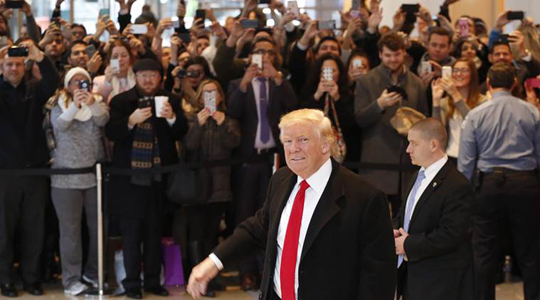Madison, Nov 26: President-elect Donald Trump pressed forward Friday with two more administration picks, as failed Green Party candidate Jill Stein took new steps to force recounts across key Midwestern battlegrounds that could complicate Trump's push for national unity.

Stein, who earned little more than 1 percent of the national vote, formally requested a Wisconsin recount Friday afternoon, vowing to do the same in the coming days in Michigan and Pennsylvania. Wisconsin officials confirmed Friday evening they would move forward with the first presidential recount in state history. There is no evidence of election tampering in the states where Trump scored razor-thin victories, but Green Party spokesman George Martin insisted “the American public needs to have it investigated to make sure our votes count.”
“We're doing this to ensure the integrity of our system,” he said.
Trump's team ignored questions about the looming recounts. Set to assume the presidency in 55 days, he was focused instead on the daunting task of building an administration from scratch.
Gathered with family at his Mar-a-Lago Palm Beach estate for the holiday weekend, the incoming president made two senior-level staff appointments and scheduled meetings with several more prospective administration officials.
He tapped Fox News analyst Kathleen Troia “KT” McFarland to serve as deputy national security adviser and campaign attorney Donald McGahn as White House counsel. In a statement, Trump cited McFarland's “tremendous experience and innate talent” and said McGahn “has a brilliant legal mind, excellent character and a deep understanding of constitutional law.”
Having faced criticism about the inexperience of his initial picks, Trump finds in McFarland someone who previously worked under three presidents, although none since Ronald Reagan.McGahn, a veteran Republican election lawyer, served as Trump's attorney during the campaign.
Neither position requires Senate confirmation.
Trump transition spokesman Sean Spicer said the president-elect scheduled Monday meetings with eight more prospective administration hires, a group that includes several business leaders, Pennsylvania Rep. Lou Barletta, and David Clarke, the Wisconsin sheriff who is an aggressive opponent of the Black Lives Matter movement.
Facing external pressure from Stein, there were also signs of internal discord within the president-elect's small inner circle as Trump weighed his choices for secretary of state.
The options for the nation's chief diplomat include former New York City Mayor Rudy Giuliani, who lacks foreign policy experience but was intensely loyal to Trump, and 2012 Republican presidential nominee Mitt Romney, who aggressively opposed Trump's candidacy but is largely regarded as more qualified.
Trump spokeswoman Kellyanne Conway took the unusual step of shining light on the controversy over the Thanksgiving holiday, tweeting that she had been “receiving a deluge of social media & private concerns re: Romney Some Trump loyalists warn against Romney as sec of state.”
Meanwhile, Stein announced on her website she has raised enough money to fund recounts in Wisconsin and Pennsylvania and was pursuing additional funding to do the same in Michigan.
Trump's Nov. 8 victory was unexpected and historic, by some measures.
Democratic nominee Hillary Clinton leads the national popular vote by close to 2 million votes. Trump scored narrow victories in key battleground states, however, giving him the necessary 270 electoral votes to assume the presidency.
He won in Pennsylvania. He won in Wisconsin, breaking a Democratic winning streak dating back 32 years. He holds a slim lead in Michigan, where a Republican presidential candidate hadn't won since 1988; The Associated Press still hasn't officially called that race.
Wisconsin, where Trump leads by little more than 22,000 votes, has never before conducted a presidential recount. It will this year, state administrator Michael Haas announced Friday, citing recount requests by Stein and independent candidate Rocky De La Fuente.
“The Commission is preparing to move forward with a statewide recount of votes for President of the United States, as requested by these candidates,” Haas said, noting that the recount is expected to be completed by the Dec. 13 federal deadline.
In Michigan, Trump's 10,704-vote lead is expected to be certified by the state elections board Monday. The deadline to ask for a recount is Wednesday.
A statewide recount would cost Stein roughly $790,000, said Fred Woodhams, a spokesman for the Michigan secretary of state. An opposing candidate would have seven days to file objections to the recount petition, after which the board would schedule a public hearing and later issue a ruling on the objections.
Trump's transition team indicated he was focused on the challenges of governing.
Since arriving at his Palm Beach estate Wednesday, they said, the president-elect has spoken to the prime ministers of Greece, Hungary and Sweden, along with the presidents of Panama and Slovenia.
He is expected to return to his New York City home on Sunday.





Comments
Add new comment